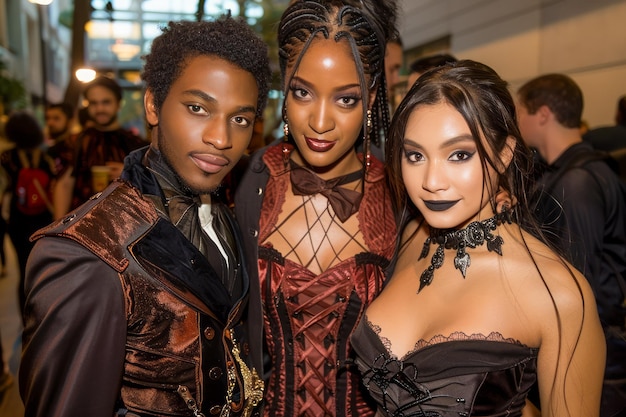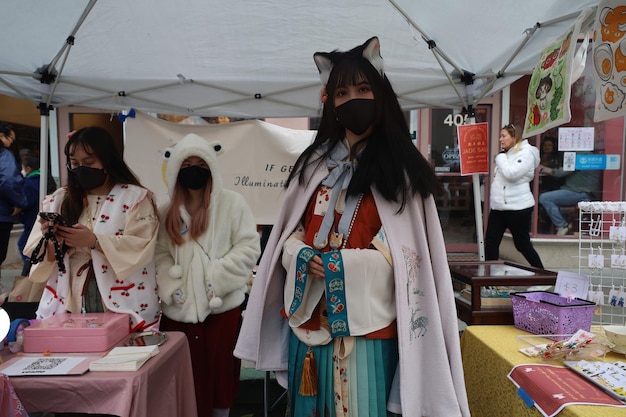Cosplay: From Niche Hobby to Billion-Dollar Industry and Cultural Mainstay

Cosplay, short for “costume play,” has evolved from a niche hobby into a thriving, billion-dollar industry and a significant cultural phenomenon, impacting entertainment, fashion, and social dynamics globally.
What started as a passionate hobby among dedicated fans has become a global phenomenon. From Niche to Mainstream: How ‘Cosplay’ Became a Billion-Dollar Industry and a Cultural Phenomenon is a journey worth exploring.
The Origins of Cosplay: A Fandom’s Genesis
Cosplay, as we know it today, has roots that stretch back to the early 20th century, but its modern form truly took shape in the latter half of the century. Understanding its origins helps appreciate its journey to the mainstream.
The term itself is a portmanteau of “costume” and “play,” coined in Japan by Nobuyuki Takahashi of Studio Hard during the 1984 World Science Fiction Convention (Worldcon) in Los Angeles. However, the act of dressing up as characters from fictional works predates this.
Early Precursors to Modern Cosplay
Before cosplay had a name, the concept was already brewing. Early examples include fans dressing up for masquerade balls and science fiction conventions in the United States.
One notable instance is Forrest J Ackerman, a science fiction fan and collector, who attended the 1939 Worldcon in New York dressed in a self-made costume inspired by the film “Things to Come.” This is often cited as one of the earliest examples of modern cosplay.
The Japanese Influence and the Birth of Cosplay Culture
Japan played a crucial role in shaping cosplay into the phenomenon it is today. The country’s vibrant manga and anime culture provided a rich source of inspiration for enthusiasts.
- Comic Market (Comiket): This biannual event in Tokyo became a central hub for cosplayers. Fans would gather to showcase their costumes, share their creations, and connect with fellow enthusiasts.
- Manga and Anime’s Impact: The detailed character designs and compelling narratives in manga and anime provided a vast playground for cosplayers to explore and recreate.
- Early Cosplay Magazines: Publications dedicated to cosplay began to emerge, providing tutorials, showcasing talented cosplayers, and further solidifying the culture.
The dedicated and passionate approach to cosplay in Japan helped solidify its identity and set the stage for its global expansion. The focus on accuracy, craftsmanship, and community became hallmarks of the culture.

The origins of cosplay highlight its organic growth from a niche interest to a recognized cultural activity. The early adopters and the unique cultural landscape of Japan were instrumental in shaping its trajectory, laying the groundwork for its future success.
From Conventions to Catwalks: The Globalization of Cosplay
Cosplay’s journey from being a subculture within specific fandoms to a globally recognized phenomenon is a story of cultural exchange, technological advancements, and the power of community.
The internet played a pivotal role in spreading cosplay beyond its initial geographical boundaries. Websites, forums, and social media platforms allowed cosplayers from around the world to connect, share their work, and inspire each other.
The Internet’s Role in Globalizing Cosplay
The internet acted as a catalyst, connecting cosplayers across borders and creating a global community.
Online forums and early social media sites became virtual meeting places for enthusiasts. They shared tips, tutorials, and photos of their costumes, creating a collaborative and supportive environment.
Cosplay at International Events
As cosplay gained popularity, it began to feature prominently at international conventions and events. These gatherings provided a platform for cosplayers to showcase their talents to a wider audience.
- Anime Expo (AX): Held annually in Los Angeles, Anime Expo became one of the largest anime conventions in North America, attracting thousands of cosplayers and fans.
- San Diego Comic-Con (SDCC): While not exclusively focused on anime and manga, SDCC embraced cosplay culture, with elaborate costumes becoming a signature part of the event.
- World Cosplay Summit (WCS): This annual event in Nagoya, Japan, brings together cosplayers from around the world to compete and celebrate the art of cosplay.
These events not only showcased cosplay to a broader audience but also facilitated cultural exchange and collaboration among cosplayers from different countries. They helped solidify cosplay as a global phenomenon.
The globalization of cosplay is a testament to the power of community and the internet. What started as a localized hobby has become a worldwide movement, connecting people through a shared passion for creativity and self-expression.
The Billion-Dollar Industry: Cosplay’s Economic Impact
Cosplay’s ascent to the mainstream has not only transformed cultural landscapes but has also spawned a significant economic impact. The industry surrounding cosplay is now estimated to be worth billions of dollars, encompassing a wide range of products and services.
The economic ecosystem of cosplay includes costume creation, prop manufacturing, event organization, and media coverage. Each of these elements contributes to the overall financial footprint of the culture.
Costume and Prop Creation
The creation of costumes and props is a central part of the cosplay industry. This includes both handmade items and commercially produced goods.
Many cosplayers are skilled artisans who design and create their own costumes, often using a variety of materials such as fabrics, foams, plastics, and metals. This has led to a thriving market for craft supplies and tools.
Events and Conventions
Events and conventions are a major driver of the cosplay industry. These gatherings generate significant revenue through ticket sales, merchandise sales, and tourism.
- Con Ticket Sales: Conventions like San Diego Comic-Con and Anime Expo generate millions of dollars in revenue from ticket sales alone.
- Cosplay-Specific Events: Specialized cosplay events, such as Dragon Con and FanimeCon, cater specifically to cosplay enthusiasts, further contributing to the industry’s revenue.
- Vendor Sales: At conventions, vendors sell a wide range of cosplay-related products, including costumes, props, wigs, and accessories.
The economic impact of cosplay extends beyond these direct sources of revenue. Cosplay-related tourism, media coverage, and online content creation also play a significant role.
Cosplay’s economic impact reflects its transformation from a niche hobby to a mainstream industry. The demand for cosplay-related products and services continues to grow, indicating a strong and sustainable economic future for the culture.

Cosplay as Performance Art: Self-Expression and Identity
Cosplay is more than just dressing up; it’s a form of performance art that allows individuals to express themselves, explore their identities, and connect with others who share their passions.
For many cosplayers, the act of embodying a character is a powerful way to explore different facets of their own personalities. It allows them to step outside of their everyday lives and inhabit a persona that resonates with them.
Embracing Characters and Exploring Personal Identity
Through cosplay, individuals can embrace characters who embody qualities they admire or aspire to possess. They can explore themes of strength, intelligence, creativity, and compassion.
Cosplay can also be a form of self-discovery. By immersing themselves in the world of a character, cosplayers can gain insights into their own values, beliefs, and desires.
Community and Social Bonds
Cosplay fosters a sense of community and belonging. Cosplayers often form close bonds with others who share their interests, creating a supportive and inclusive environment.
- Group Cosplays: Cosplaying as a group allows individuals to collaborate, share their skills, and build lasting friendships.
- Cosplay Meetups: Cosplay meetups provide opportunities for cosplayers to connect, share their work, and participate in photoshoots and other activities.
- Online Communities: Online forums and social media groups connect cosplayers from around the world, fostering a sense of global community.
Cosplay as performance art transcends the act of dressing up. It’s a form of self-expression, a means of identity exploration, and a catalyst for building meaningful connections with others. It empowers individuals to embrace their passions and find their place in a vibrant and supportive community.
Challenges and Controversies within the Cosplay Community
Like any thriving community, cosplay has faced its share of challenges and controversies. These issues often revolve around topics such as cultural appropriation, body image, harassment, and gatekeeping.
Addressing these challenges is crucial for fostering a more inclusive, respectful, and supportive cosplay community.
Cultural Appropriation and Representation
Cultural appropriation is a significant concern within the cosplay community. This involves cosplaying characters from cultures other than one’s own without proper understanding or respect.
It’s essential for cosplayers to approach characters from different cultures with sensitivity, doing their research and avoiding stereotypes or caricatures. Respectful representation is key.
Body Image and Sizeism
Body image issues and sizeism are also prevalent within the cosplay community. Some cosplayers face criticism or exclusion based on their body size or shape.
- “Canon” Body Types: The idea that characters should only be cosplayed by individuals who resemble their “canon” body types is harmful and exclusionary.
- Promoting Body Positivity: Many cosplayers are actively working to promote body positivity and inclusivity within the community, encouraging people of all shapes and sizes to embrace cosplay.
- Challenging Stereotypes: Challenging stereotypes about who can and cannot cosplay certain characters is crucial for creating a more welcoming and accepting environment.
Harassment, gatekeeping, and other forms of negativity can detract from the positive aspects of cosplay culture. Addressing these issues requires ongoing dialogue, education, and a commitment to fostering a more inclusive and supportive community.
The Future of Cosplay: Innovation and Evolution
Cosplay is a constantly evolving art form, and its future promises even greater innovation, creativity, and inclusivity. Technological advancements, evolving social norms, and the ongoing growth of fandoms will shape the next chapter of cosplay culture.
From the use of 3D printing and advanced materials to the expansion of cosplay into new mediums and platforms, the possibilities are virtually endless.
Technological Advancements in Costume Creation
Technology is revolutionizing the way costumes are created, making it easier than ever to bring complex and intricate designs to life.
3D printing allows cosplayers to create custom armor pieces, props, and accessories with incredible precision and detail. Software programs enable cosplayers to design and model their creations before bringing them into the physical world.
Cosplay in New Mediums and Platforms
Cosplay is expanding beyond conventions and photoshoots, finding new avenues for expression and engagement.
- Virtual Cosplay: With the rise of virtual reality and augmented reality, cosplayers can create and showcase their costumes in digital environments.
- Cosplay on Social Media: Platforms like TikTok and Instagram provide new opportunities for cosplayers to share their work, connect with fans, and build their personal brands.
- Cosplay in Gaming: Some video games now allow players to create and customize their characters with cosplay-inspired outfits, blurring the lines between virtual and real-world cosplay.
The future of cosplay is bright, filled with opportunities for innovation, creativity, and community building. As technology advances and social norms evolve, cosplay will continue to transform and adapt, remaining a vibrant and relevant part of global culture. The journey From Niche to Mainstream: How ‘Cosplay’ Became a Billion-Dollar Industry and a Cultural Phenomenon will continue to evolve as time goes on.
| Key Point | Brief Description |
|---|---|
| 🎭 Origins of Cosplay | Evolved from early fandom dress-up to a defined culture in Japan. |
| 🌐 Globalization | The Internet and international events propelled cosplay worldwide. |
| 💰 Economic Impact | A billion-dollar industry driven by costumes, events, and media. |
| ✨ Future Trends | Innovation in tech and inclusivity in representation shapes future cosplay. |
FAQ
▼
Cosplay, short for “costume play,” is the practice of dressing up as characters from fictional works, such as anime, manga, video games, and comic books. It involves creating and wearing costumes, often accompanied by props and accessories, to embody the character.
▼
Cosplay’s modern form originated in Japan, gaining popularity in the 1970s and 1980s at events like Comic Market (Comiket). The term “cosplay” was coined by Nobuyuki Takahashi in 1984, but the practice had precursors in early 20th-century masquerade balls and science fiction conventions.
▼
The cosplay industry is estimated to be worth billions of dollars globally. It encompasses costume creation, prop manufacturing, event organization, and media coverage. Conventions, vendors, and online content creators all contribute to the industry’s revenue.
▼
The cosplay community faces challenges such as cultural appropriation, body image issues, harassment, and gatekeeping. Addressing these issues requires ongoing dialogue, education, and a commitment to fostering a more inclusive and supportive environment.
▼
Technology is greatly impacting cosplay, with 3D printing allowing for detailed prop and armor creation, and virtual reality offering new ways to showcase costumes. Social media platforms provide avenues for cosplayers to share their work and connect with fans.
Conclusion
Cosplay’s remarkable transformation from a niche hobby to a billion-dollar industry and a global cultural phenomenon is a testament to the power of creativity, community, and self-expression. As it continues to evolve, cosplay will undoubtedly remain a vibrant and influential force in entertainment, fashion, and social dynamics.